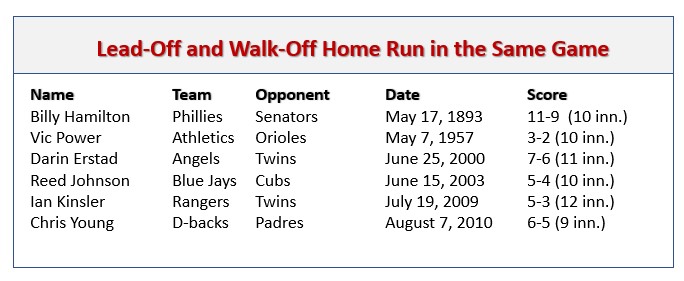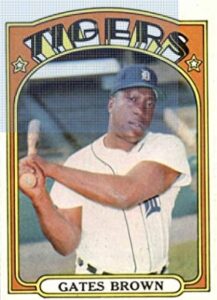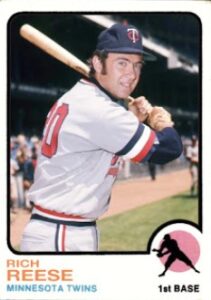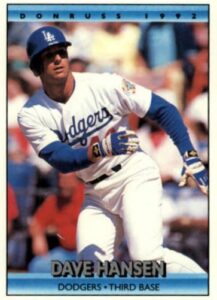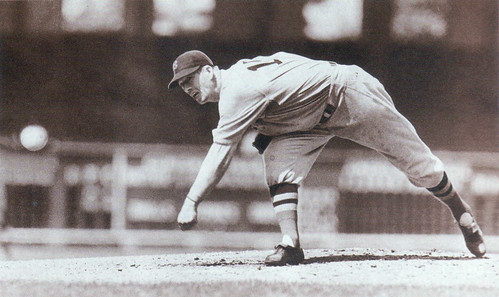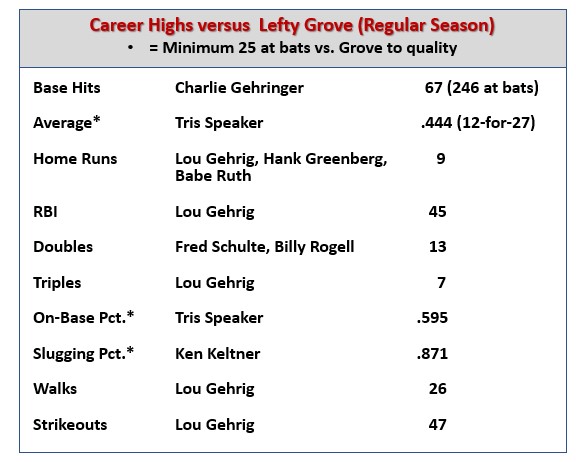Here’s another of those Baseball Roundtable blog posts that illustrate how “one thing leads to another” when I start looking into a topi. I recently completed a post on “Pinch-Hit Ultimate Grand Slams” – walk-off Grand Slams when the pinch-hitter’s team needed all four runs to chalk up the victory. (For that post, click here.) That research led me to look further into game-ending “walk-offs” of all kinds. Here are a few that I found particularly unique, interesting or historic.
Truly the All-Time WALK-Off
We hear a lot about walk-off home runs, but the Dodgers – on July 2, 2019 – pulled off the ultimate Walk–off. Los Angeles came into the bottom of the ninth trailing the Diamondbacks 4-3. Arizona brought in closer Greg Holland, who quickly recorded the first two outs. The Dodgers were now down to their last out, not knowing they were destined to mount a two-run, game-winning rally without putting the ball in play.
Dodgers’ LF Chris Taylor next faced Holland and put the Dodgers down to their last strike before drawing a full-count count walk. Then Russell Martin pinch hit for pitcher Yimi Garcia and drew a full-count walk. Next up was CF Alex Verdugo, who walked on five pitches. Then came 1B Matt Beaty, who walked on four pitches – tying the game at three runs apiece. At this point, the Diamondbacks brought T.J. McFarland to the mound, but the results were pretty much the same. RF Cody Bellinger walked on a 3-2 count, forcing in the winning run on a true walk-off walk. The entire two-out, five-walk series took 28 pitches. Game. Set. Match.
A Walk-Off … No, I Mean Run-Off, Victory
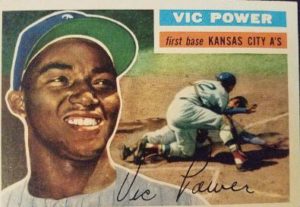 On this August 14, 1958, Vic Power became just the eleventh player in MLB history to steal home twice in one game – a feat that has not been accomplished since. Not only that, his second steal of home came in the bottom of the tenth inning, giving Power’s Indians a 10-9 win over Detroit – a true run-off, walk-off.
On this August 14, 1958, Vic Power became just the eleventh player in MLB history to steal home twice in one game – a feat that has not been accomplished since. Not only that, his second steal of home came in the bottom of the tenth inning, giving Power’s Indians a 10-9 win over Detroit – a true run-off, walk-off.
Here’s how that tenth inning went. 1B Mickey Vernon grounded out (Frank Lary was on the mound). Then, Power (playing third base that day) singled to right (his third hit of the day). Catcher Russ Nixon followed with another single, Power moving to second. LF Minnie Minoso grounded to short, with Power moving on to third, Nixon forced at second and Minoso reaching first on the fielder’s choice. CF Larry Doby was intentionally walked, loading the bases and bringing RF Rocky Colavito (in the midst of a 41-home run, 113 RBI season and with three RBI on the day) to the dish. On the fourth pitch to the Indians’ slugger, Power – who had been scampering up and down the third base line – broke for the plate and ended the game on a “run-off” steal of home. For more on MLB steals of home, click here.
Power, by the way, was not a very likely candidate to swipe home twice in a game. Going into that August 14 tilt, he had exactly one stolen base on the season – and he did not steal another bag that season. In fact, in twelve MLB seasons, Power stole just 45 bases (and was caught 35 times).
Kind of a Brummer – in a Good Way
On August 22, 1982, Cardinals’ catcher Glenn Brummer produced a notable walk-/run-off win. Brummer’s Cardinals were tied with the Giants in the bottom of the 12th inning, with two-outs and a 2-2 count on LF David Green (facing Gary Lavelle). On Lavelle’s fifth pitch to Green, Brummer broke for home, getting in safety (to win the game) on a head first slide. What makes this one memorable (at least to me) is that Brummer stole only four bases (and was thrown out eight times) in his five-season MLB career.
Holy Moses
A total of 35 MLB games have ended with a steal of home. Wally Moses is the only player to accomplish the feat twice – once against the White Sox and once for them. On August 20, 1940, Moses’ tenth-inning steal of home gave his Philadelphia Athletics a 4-3 win over the White Sox. Then, on July 7, 1943, his fourteenth-inning swipe of home plate gave his White Sox a 3-2 win over the Red Sox.
You’ll Never see that Again
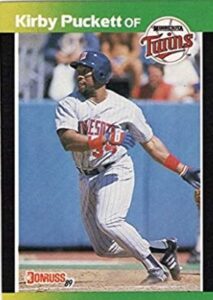 On May 28, 1993, the Cleveland Indians scored a pair of runs in the top of the ninth to tie the Minnesota Twins at 6-6. With Ted Power pitching, Twins’ 2B Chuck Knoblauch opened the bottom of the ninth inning with a single to center. That brought Eric Plunk in from the bullpen and he was greeted by a double to left (on a 1-2 pitch) by 1B Dave McCarty. Knoblauch was held at third. So, with runners on first and third, one out, the game on the line and the Twins’ best hitter (CF Kirby Puckett) coming up, the Indians decided to follow the traditional strategy – intentionally walking the future Hall of Famer to set up the double play. Oops! Plunk’s first intentionally high-and-outside pitch got past catcher Junior Ortiz and Knoblauch scampered home with the winning run-off run. With today’s “wave-em-to-first” intentional walk rule, we’ll never see this ending again.
On May 28, 1993, the Cleveland Indians scored a pair of runs in the top of the ninth to tie the Minnesota Twins at 6-6. With Ted Power pitching, Twins’ 2B Chuck Knoblauch opened the bottom of the ninth inning with a single to center. That brought Eric Plunk in from the bullpen and he was greeted by a double to left (on a 1-2 pitch) by 1B Dave McCarty. Knoblauch was held at third. So, with runners on first and third, one out, the game on the line and the Twins’ best hitter (CF Kirby Puckett) coming up, the Indians decided to follow the traditional strategy – intentionally walking the future Hall of Famer to set up the double play. Oops! Plunk’s first intentionally high-and-outside pitch got past catcher Junior Ortiz and Knoblauch scampered home with the winning run-off run. With today’s “wave-em-to-first” intentional walk rule, we’ll never see this ending again.
I’ll Take a Pass on That
On August 15, 1970, with the Mets up on the Braves 2-1 and the Braves batting in the bottom of the ninth with one out and the bases loaded, Tom Seaver whiffed Atlanta catcher Blob Tillman. The ball, however, eluded Mets’ catcher Jerry Grote for a passed ball, allowing the tying run (Tony Gonzalez) to score from third base. Grote doubled down on the miscue with an errant throw to the plate, allowing Rico Carty – who had been at second base – to score the winning tally. So, Atlanta fans got to witness a game-ending, game-winning strikeout.
Walking Off a No-No
 On August 23, 2017, only an error by third baseman Logan Forsythe had kept him from tossing nine perfect innings against the Pirates. After nine frames, he had given up no hits and no walks, while striking out ten (including Pittsburgh 2B Josh Harrison twice). Unfortunately, over 9 ½ innings, Hills’ teammates did not put any runs up on the score board. Pirate’s starter Trevor Williams had given up no runs – on seven hits and four walks – over eight frames; reliever Felipe Vazquez had pitched a one-hit scoreless ninth; and Juan Nicasio had pitched a 1-2-3 top of the tenth.
On August 23, 2017, only an error by third baseman Logan Forsythe had kept him from tossing nine perfect innings against the Pirates. After nine frames, he had given up no hits and no walks, while striking out ten (including Pittsburgh 2B Josh Harrison twice). Unfortunately, over 9 ½ innings, Hills’ teammates did not put any runs up on the score board. Pirate’s starter Trevor Williams had given up no runs – on seven hits and four walks – over eight frames; reliever Felipe Vazquez had pitched a one-hit scoreless ninth; and Juan Nicasio had pitched a 1-2-3 top of the tenth.
Leading off the bottom of the tenth was Harrison (zero-for-three with two strikeouts in the game). Harrison hit a 2-1 pitch for a walk-off, game-winning home run to left – becoming the first player to end an extra-inning no-hitter with a walk-off long ball. (It was his 16th round tripper of the season. (Lots of qualifiers there, but – as I’ve said before – in baseball we count everything.) For past post on no-hitters lost late in the game, click here.
Latest Walk Off Win Ever
The longest game ever to end in walk-off fashion took 25 innings, eight hours and six minutes and two days to complete. It started on May 8, 1984, with the Brewers facing the White Sox at Comiskey – and seemed about to end twice before the 25th frame finale.
All in a Day’s Work
The longest game (in innings) took place on May 1, 1920 – as the Brooklyn Robins and Boston Braves played 26 innings (game called due to darkness) to a 1-1 tie. To show how the game has changed, the 26 frames were completed in just under four hours – and both starting pitchers (Joe Oeschger and Leon Cadore) went the distance.
The Brewers/White Sox game was tied 1-1 going into the ninth. Brewers’ SS Robin Yount opened the inning against Britt Burns with a double to left. After one out, he stole third and scored on a throwing error by catcher Carlton Fisk. Then, Milwaukee 1B Ted Simmons singled, went to second on a Burns’ wild pitch and scored on a single by LF Ben Oglivie – giving the Brew Crew a two-run lead. In the bottom of the inning, White Sox’ LF Tom Paciorek led off against Rollie Fingers and was safe on an error. Fingers retired the next two batters and the Brewers were one out from the win. However, Sox’ 2B Julio Cruz delivered an RBI double and CF Rudy Law followed with an RBI single – tying the game at three apiece. That’s where the score stayed until the end of the seventeenth inning, when it was suspended due to curfew rules.
The game resumed on May 9 and stayed at 3-3 until the top of the 21st, when Oglivie popped a two-out, three-run home run off Ron Reed to give the Brewers a 6-3 edge. Game over? Not so fast! In the bottom of the 21st, Law reached on an error and scored on a single by catcher Carlton Fisk (off Chuck Porter). Marc Hill (now in at 1B) then walked and, after Dave Stegman (now in at DH) fanned, RF Harold Baines walked and Paciorek delivered a two-run single. That ended the scoring and kept the game knotted, now at 6-6.
There was no more scoring until one-out in the bottom of the 25th, when Baines homered off Porter – giving the win to “reliever” Tom Seaver, who pitched the top of the 25th. It was the latest-ever MLB walk-off hit.
A few side notes: Carlton Fisk was behind the plate for the ChiSox for all 25 innings (He went three-for-eleven with a walk). Seven different players occupied the number-three spot in the White Sox batting order – although only five had a plate appearance. Chuck Porter, who took the loss, pitched the final 7 1/3 inning for the Brewers. For more on this contest some of MLB’s longest game, click here.
By The Numbers
In 1959, the Pirates racked up a single-season record 18 walk-off victories – despite finishing in fourth place, just two games over .500. That same campaign, they also won a pair of doubleheaders in which they took both games in walk-off fashion. They are one of five teams to accomplish that feat.
Here’s how they did it.
May 24 – Game One … 2-1 over Reds
The game was scoreless until the top of the ninth, when the Reds tallied once. The Pirates scored twice in the bottom of the inning, winning it on a two-out, walk-off, RBI double by PH Danny Kravitz.
May 24 – Game Two … 5-4 over the Reds
The Pirates scored twice in the bottom of the ninth to tie the game at 4-4. They won it in the tenth on a two-out, walk-off, RBI double by PH Smokey Burgess.
August 30 – Game One … 2-1 over Phillies
The Pirates won this one on a ninth-inning, two-out, RBI single by LF Bob Skinner.
August 30 – Game Two …. 7-6 over the Phillies
The Pirates were down 5-0 in this one at the end of six innings. They scored one in the seventh; two in the eighth; and two (to tie the game) in the ninth. In the top of the tenth, the Phillies tallied once to take the lead, but the Pirate prevailed on a one-out, two-run double by 1B Dick Stuart in the bottom of the inning.
Side note: 1959 saw Pirates’ reliever Roy Face put up his historic 18-1 (.947 winning percentage, 10 save, 2.70 ERA) season. Nine of his wins came in the Pirates’ 18 walk-off victories.
“Power”ful Book Ends
May 7, 1957, Vic Power’s Athletics were playing the Orioles in Kansas City. Power led off the bottom of the first for the A’s – and hit a home run to left off starter Hal Brown – Power’s first long ball of the season. Fast forward to the bottom of the tenth, with the game tied at 2-2. With one out – and Brown still on the mound – Power hit his second home run of the season (again to left field), giving the A’s a walk-off win and also making Power just the second player to hit a game opening and game-ending home run in the same contest – and he did it with his first two homers or the season. (For more on players – before and after Power – to open and close a game with a long ball click here.)
The Walk-Off Home Run Turned Double
One of the best (and most historic) games ever pitched ended in a walk-off win – but not for the team and pitcher you might expect.
 On May 26, 1959, Harvey Haddix took the mound against the power-laden Milwaukee Braves (who had won the National League pennant the previous two seasons and came into the game again leading the league). Haddix retired the first 36 hitters in order – fanning eight, carrying a perfect game into the bottom of the 13th (the longest perfect outing ever).
On May 26, 1959, Harvey Haddix took the mound against the power-laden Milwaukee Braves (who had won the National League pennant the previous two seasons and came into the game again leading the league). Haddix retired the first 36 hitters in order – fanning eight, carrying a perfect game into the bottom of the 13th (the longest perfect outing ever).
Unfortunately, the Braves’ Lew Burdette, despite giving up 12 hits and fanning only two, had held the Pirates scoreless. (Like Haddix, Burdette had not issued a single free pass.) Milwaukee 2B Felix Mantilla led off the 13th by reaching on error by Pirates’ third baseman Don Hoak. Slugging 3B Eddie Mathews bunted Mantilla over to second, which led to an intentional walk to RF Hank Aaron, bringing up 1B Joe Adcock. Adcock rapped a 1-0 pitch over the right field fence for what appeared to be a three-run walk-off home run. However, the Braves, in celebrating the tension-filled victory, forgot how to run the bases. Adcock passed Aaron between second and third and, after some deliberation, Adcock was called out – ultimately changing his three-run homer to a one-run, walk-off double. So, despite 12 perfect innings, Haddix lost the no-hitter, the shutout and the game itself. But he did etch his name forever into baseball lore; and countless trivia quizzes.
Taking One (or Two) For the Team
On September 15, 2020, the Cubs came up in the bottom of the ninth tied with the Indians at five runs apiece. The Indians brought Oliver Perez in for the save and he retired the first batter – LF Ian Happ – on a fly out to RF. Next 3B Kris Bryant walked on a 3-2 pitch (in an eight-pitch at bat). Then, 1B Anthony Rizzo singled Bryant to third. That brought on Nick Wittgren to face DH Wilson Contreras, who was hit by a 1-1 pitch – loading the bases. On the very next pitch, PH Cameron Maybin was hit by a Wittgren pitch – leading to walk/hit-off 6-5 Cubs win.
Jim Thome holds the MLB career record for walk-off home runs at 13.
Inside-Out(side)
This post started with the research on pinch-hit “Ultimate Grand Slams” – walk-off Grand Slams hit when your team is down three runs. In that research, I came across a couple of non-pinch Ultimate Slams that interested me – one inside the park and one that went out of the field of play.
 The first occurred on July 25, 1956. The Pirates entered the bottom of the ninth of a game against the Cubs trailing 8-5. With Turk Lown on the mound for the Cubs, the Pirates loaded the bases on two walks and a single. The Cubs then went to Jim Brosnan to face 21-year-old Roberto Clemente, who hit Brosnan’s first pitch over left fielder Jim King’s head. The line drive struck the fence, rebounding along the outfield warning track. The three base runners scampered home, tying the score. As Clemente approached third base, coach Bobby Bragan was putting up the “stop” sign – which the speeding Clemente ignored – ultimately sliding home with the winning walk-/run-off tally in a 9-8 win. In the process, he became, and still is, the only player with a inside-the-park Ultimate Grand Slam. Clemente, by the way, is reported to have paid a $25 fine for running through the stop sign.,
The first occurred on July 25, 1956. The Pirates entered the bottom of the ninth of a game against the Cubs trailing 8-5. With Turk Lown on the mound for the Cubs, the Pirates loaded the bases on two walks and a single. The Cubs then went to Jim Brosnan to face 21-year-old Roberto Clemente, who hit Brosnan’s first pitch over left fielder Jim King’s head. The line drive struck the fence, rebounding along the outfield warning track. The three base runners scampered home, tying the score. As Clemente approached third base, coach Bobby Bragan was putting up the “stop” sign – which the speeding Clemente ignored – ultimately sliding home with the winning walk-/run-off tally in a 9-8 win. In the process, he became, and still is, the only player with a inside-the-park Ultimate Grand Slam. Clemente, by the way, is reported to have paid a $25 fine for running through the stop sign.,
Now for one that left the field of play. Have to go with the well-known and historic Giants’ 5-4 win over Dodgers in the 1951 pennant-deciding playoff game. In that one, the Giants trailed 4-1 going into the bottom of the ninth. With Don Newcombe on the mound, the Giants started the ninth with a single by SS Al Dark, a single by RF Don Mueller, a foul pop out by LF Monte Irvin and run-scoring double by 1B Whitey Lockman. Ralph Branca came on to pitch and 3B Bobby Thomson hit his second pitch for a three-run, walk-off home run – and, of course, the Giants ticket to the World Series.
What a Way to Win a World Series
Okay, we all know about Bill Mazeroski’s tenth-inning, Game-Seven home run (off Ralph Terry) that gave the Pirates a walk-off 10-9 win and the 1960 World Series title. Why is it here? Because it gave the Pirates the Series’ despite the fact that, over the seven games, they were out hit by the Yankees; .338 to .256; 91 hits to 60; ten home runs to four – and were outscored 55 to 27. In the Series, the Pirates pitching staff put up a 7.11 ERA, to 3.54 for the Yankees. For more detail on this exciting World Series, click here.
Primary Resources: Baseball-Reference.com; Baseball-Almanac.com; MLB.com
WE HAVE A WINNER! BBRT’S LATEST PRIZE PACK.
Rick from Fargo, North Dakota is the winner of Baseball Roundtable’s latest prize pack. (Watch BBRT posts for future drawings.) Rick is receiving: 1) A complete 1984 Topps baseball card set; 2) a Twins 40th Anniversary Tony Oliva bobblehead; 3) an autographed 8 x 10 of Tony Oliva; 4) a Magnum Comics Mickey Mantle First Edition comic book (with commemorative Mantle card); and 5) a first edition copy of “Quotable Baseball Fanatics.”
 Baseball Roundtable is on the Feedspot list of the Top 100 Baseball Blogs. To see the full list, click here.
Baseball Roundtable is on the Feedspot list of the Top 100 Baseball Blogs. To see the full list, click here.
I tweet baseball @DavidBBRT
Follow/Like Baseball Roundtable’s Facebook Page here. More baseball commentary; blog post notifications.
Member: Society for American Baseball Research (SABR); Negro Leagues Baseball Museum; The Baseball Reliquary.


